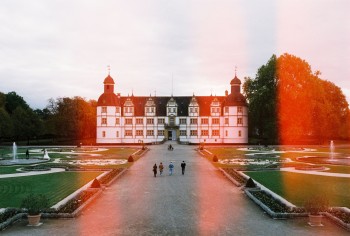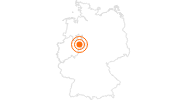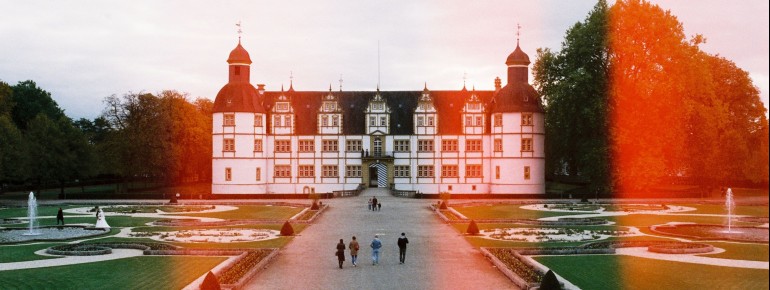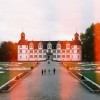Contents
Description

Nestled within the green oasis of Paderborn, the magnificent Neuhaus Castle rises as a masterpiece of Weser Renaissance architecture, captivating visitors with its historical grandeur and idyllic gardens. However, this castle is more than just an architectural gem—it is surrounded by the expansive Castle and Riverside Park, a paradise for nature lovers. Here, historic splendor meets blooming landscapes, intriguing museums, extensive walking paths, and hidden corners perfect for daydreaming.
The heart of the complex is the impressive Neuhaus Castle, a stunning example of Weser Renaissance architecture. Encircled by a historic moat and meticulously designed flower beds inspired by historical models, the baroque garden stands as a living testament to landscape artistry. Although the castle mainly serves as a school today, its opulent Hall of Mirrors enchants visitors with its elegant atmosphere. It’s not just a venue for events—it’s a dream location for unforgettable weddings.
But the castle has even more to offer: Several museums of the city of Paderborn are located in the historic buildings. From the Natural History Museum in the former stables to the Municipal Gallery and the Nachtmann Collection, art and culture enthusiasts can embark on a diverse journey of discovery. During summer, the outdoor stage "Freilichtbühne Schloss Neuhaus e.V." presents theatrical performances for audiences of all ages amidst nature. At the Forum of Young Artists in the Castle and Riverside Park, modern art blends with historic charm. Regular exhibitions and events provide a platform for young talents across various art forms, including painting, sculpture, and experimental installations. Visitors are invited to explore new perspectives and draw inspiration from the creative energy around them.
Spanning 42 hectares around Neuhaus Castle, the Castle and Riverside Park forms part of a green corridor extending to Lippesee Lake. Areas like the Pader Meadow, the Riverside Park with Kruggelfeld, and the historic castle gardens offer a mix of traditional garden design and modern landscape architecture. Well-maintained paths invite visitors to take long walks, bike rides, or engage in sports, while playgrounds and nature exploration areas especially appeal to families.
Adults can also enjoy their leisure time here: The 18-hole mini-golf course, complete with a beer garden and bistro, is perfect for laid-back summer outings. Classic game enthusiasts can enjoy the park’s well-equipped boules courts, where friendly matches take place in a serene setting. The park is worth visiting year-round, offering free access to scenic trails and some attractions in every season.
The Outdoor Classroom
Nature itself becomes a teacher in this park. School groups can take part in hands-on, outdoor learning sessions, discovering local flora and fauna up close. Designated areas, such as the “Outdoor Classroom” provide the ideal setting for observation and exploration in the open air after prior registration.
Historical Information
Neuhaus Castle and its adjoining Castle and Riverside Park offer a fascinating journey through history. While the castle, an imposing Weser Renaissance building, tells of the rich history of the prince-bishops of Paderborn, the extensive park today offers a blooming oasis that was given a new lease of life by the "Landesgartenschau" in 1994.
From Medieval Tower to Grand Residence
The castle’s origins date back to 1370 with the construction of “Haus Spiegel,” a Gothic residential tower commissioned by Bishop Heinrich von Spiegel. Over the centuries, the complex grew steadily: in 1525, Bishop Erich of Brunswick introduced the Weser Renaissance style with the addition of “Haus Braunschweig.” By 1597, under Bishop Dietrich IV of Fürstenberg, the castle was completed with its characteristic four towers. The residence underwent over 230 years of construction, evolving into an opulent home where Clemens August I of Bavaria left his mark in the 18th century with lavish renovations and the creation of the baroque garden.
The castle’s golden age ended in 1802 with the secularization of church property during early 19th-century political upheavals, transferring ownership to Prussia. It later served as a garrison and, after World War II, was converted into a school. However, the original elegance was revived—particularly in the Hall of Mirrors, once the dining room of the prince-bishops, which is now a popular venue for events. Since 2017, visitors have been able to delve into the castle’s rich history through the Residence Museum.
The Castle and Riverside Park: From Agricultural Land to Natural Paradise
The 1994 "Landesgartenschau" marked a turning point for the area. Previously, the land consisted of canalized rivers and agricultural plots. Thanks to extensive renaturation efforts led by landscape architect Christhard Ehring, rivers like the Pader, Lippe, and Alme were restored to their natural courses, green spaces were created, and new themed areas emerged. The transformation proved so successful that the park has been preserved and remains a beloved recreational spot to this day. Its inclusion in the European Garden Heritage Network is a testament to its significance and continued appeal.
How to get there
Neuhaus Castle is located in the district of the same name in the city of Paderborn, North Rhine-Westphalia. Reaching it by car is simple: take the A33 highway and exit at Paderborn-Schloß Neuhaus. From there, follow Münsterstraße towards Paderborn and turn onto Residenzstraße heading toward Neuhaus Center. Just before the castle, turn left onto Marstallstraße.
There are only a few parking spaces directly at the castle, but larger parking facilities are available nearby, such as at Amtsweg, Almering, or Merschweg.
For those traveling by public transport, the castle is easily accessible from Paderborn’s main train station via bus lines 1, 8, or 11, which stop at Schloß Neuhaus. From there, it’s just a short walk to the entrance, making it quick and convenient to visit this magnificent site.




